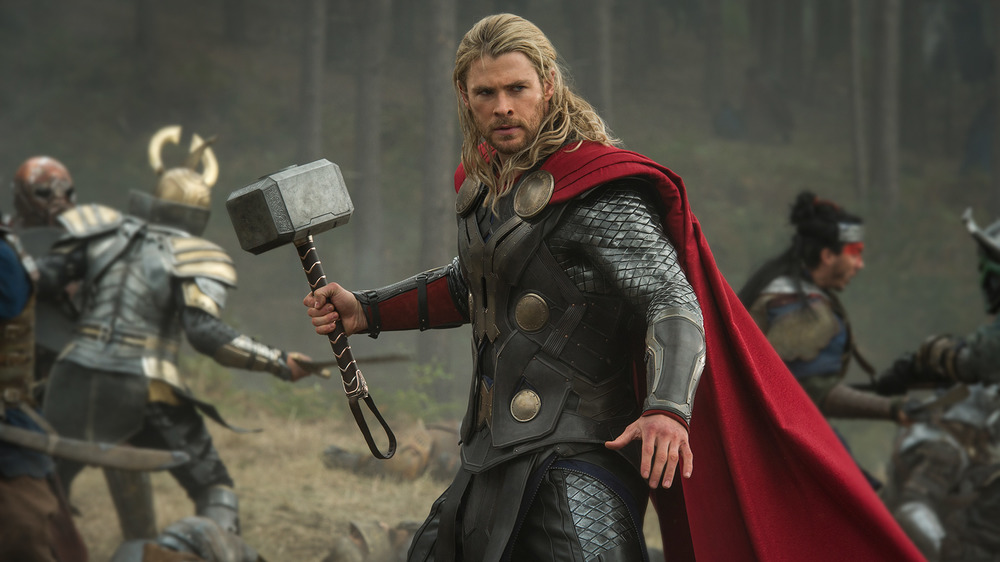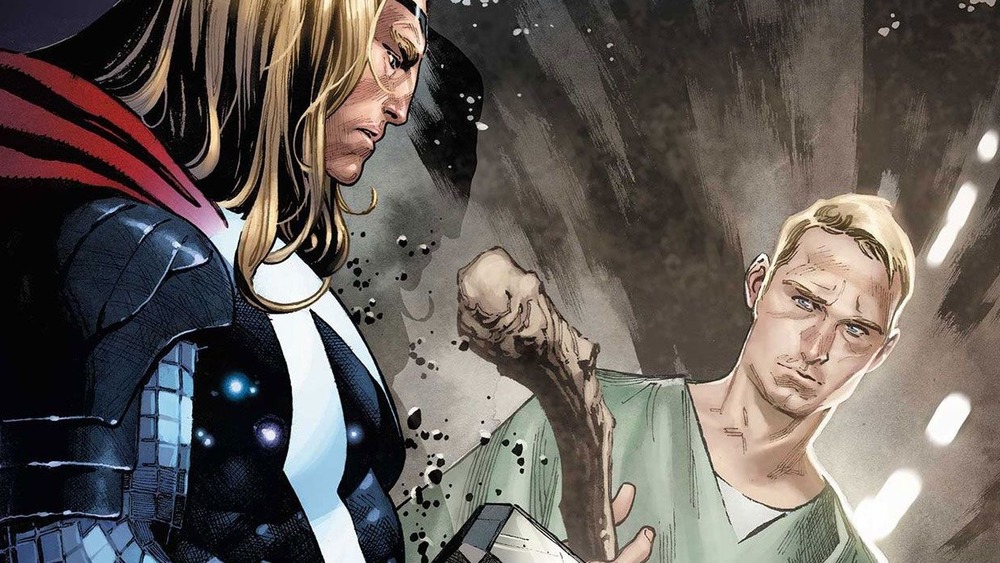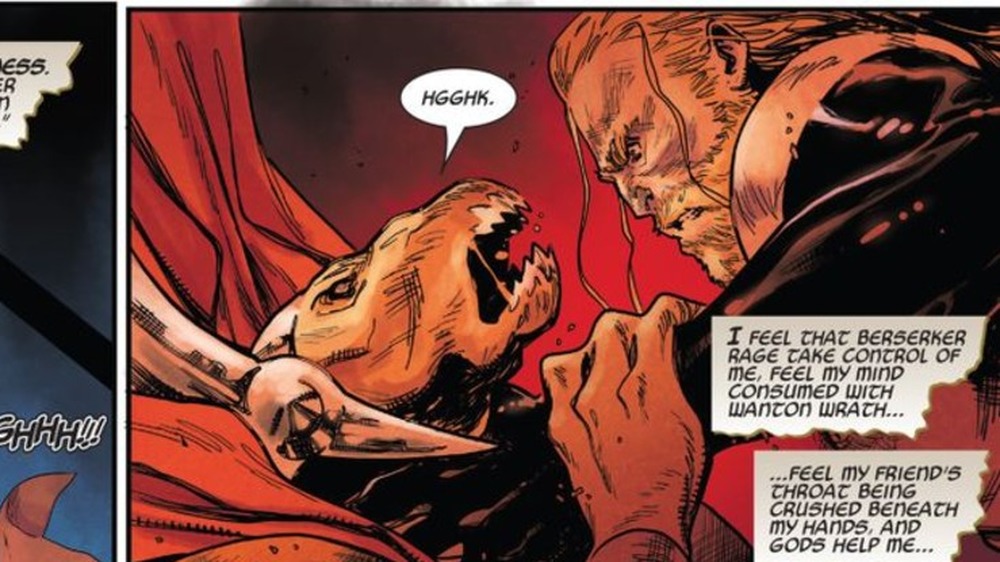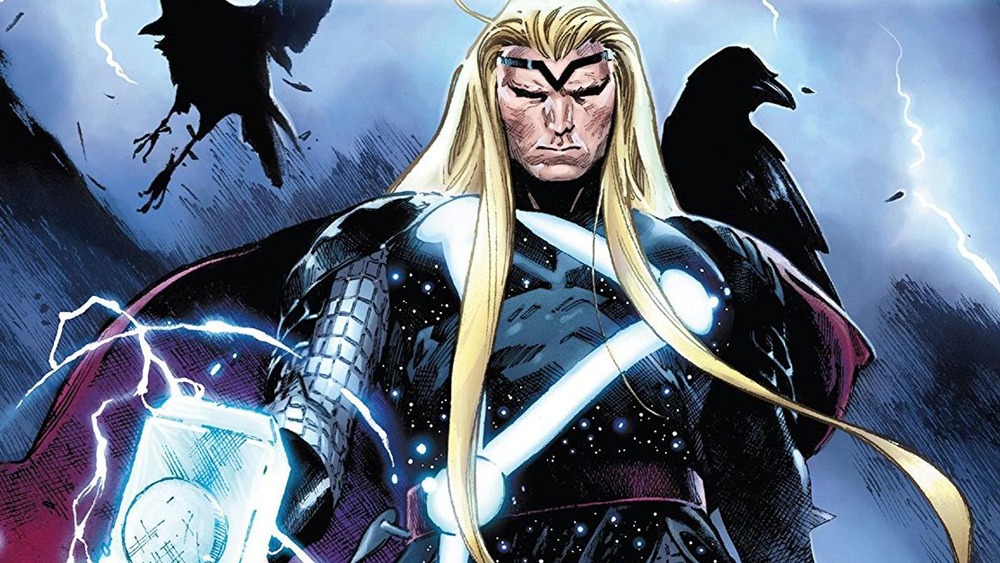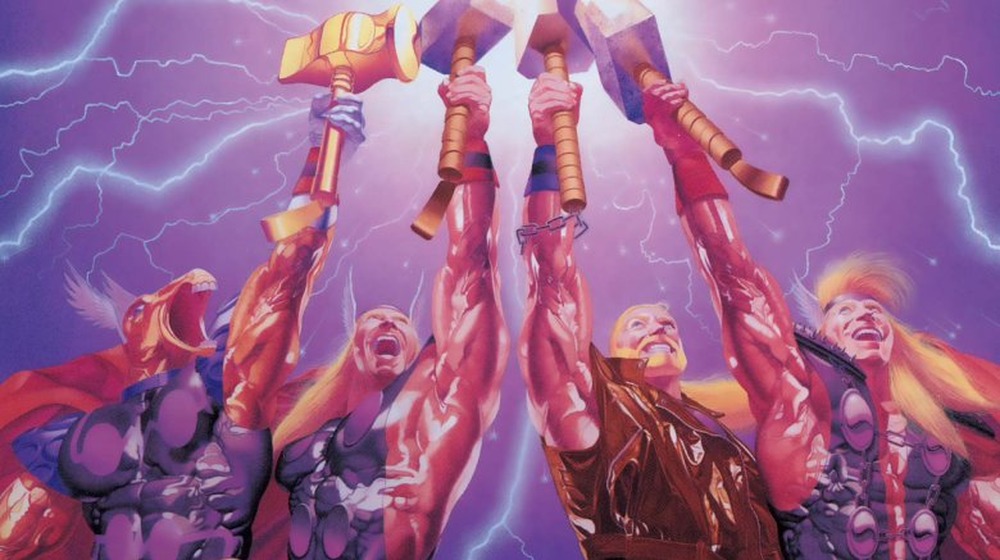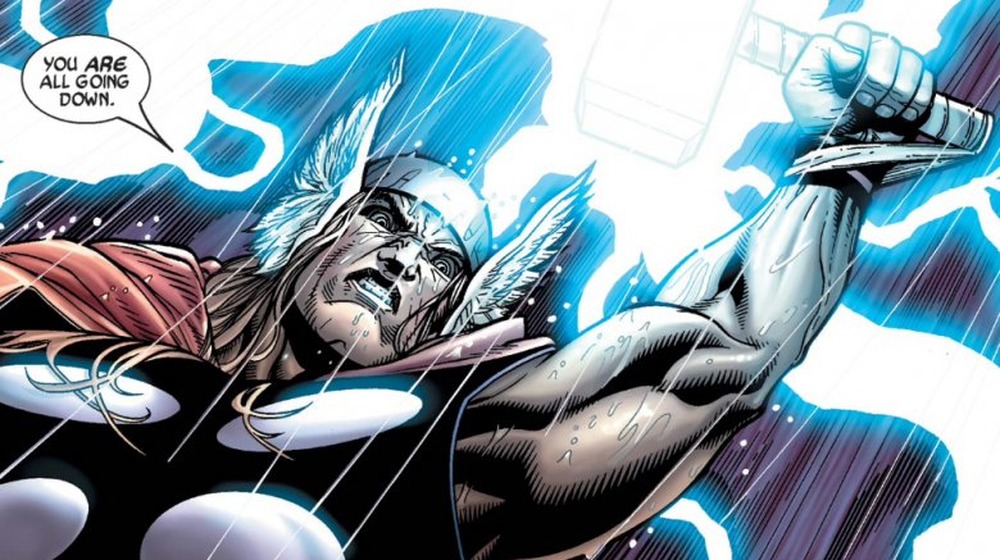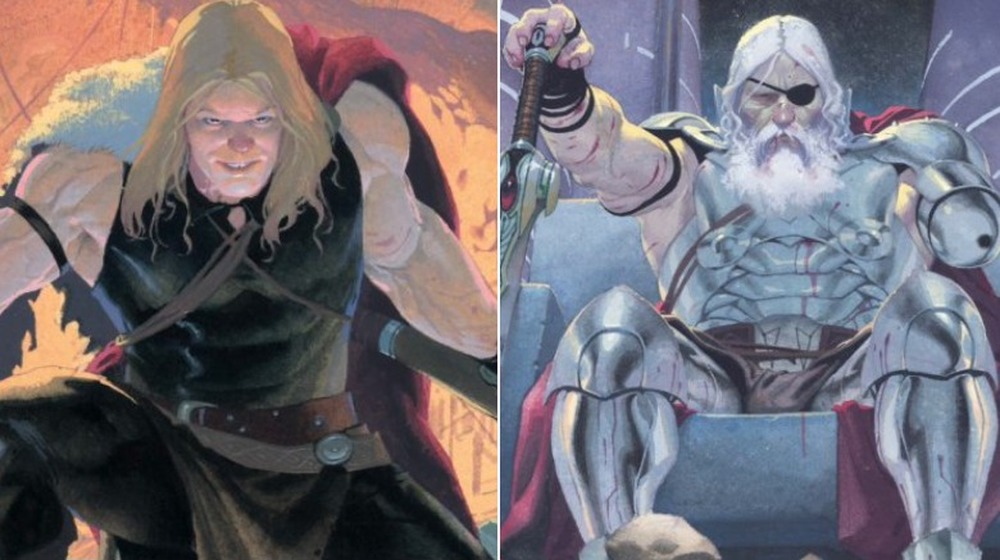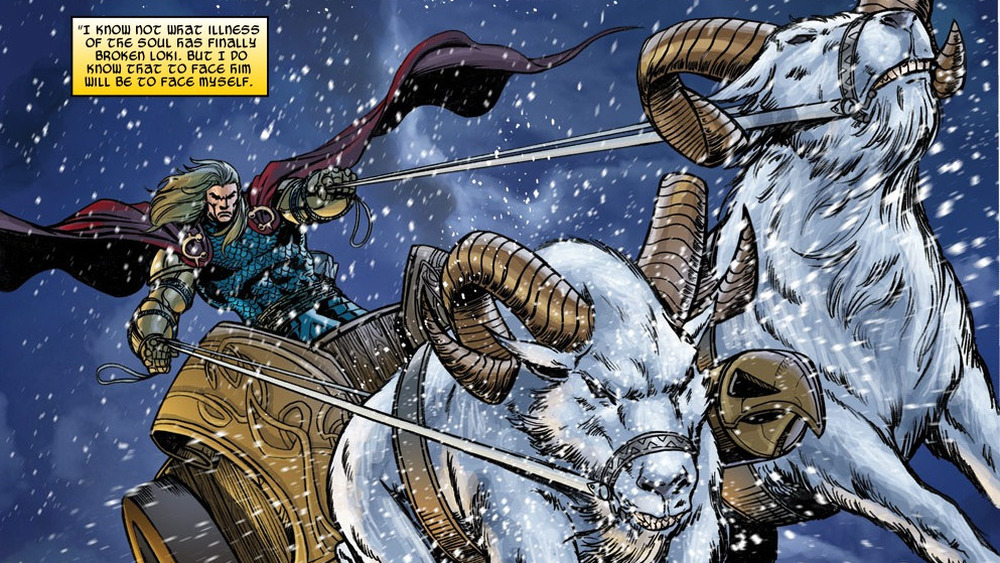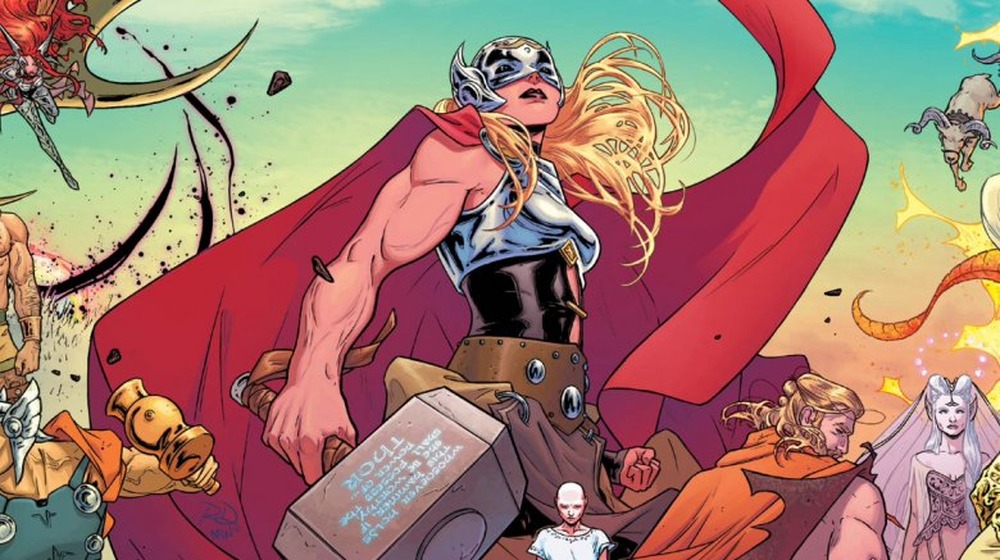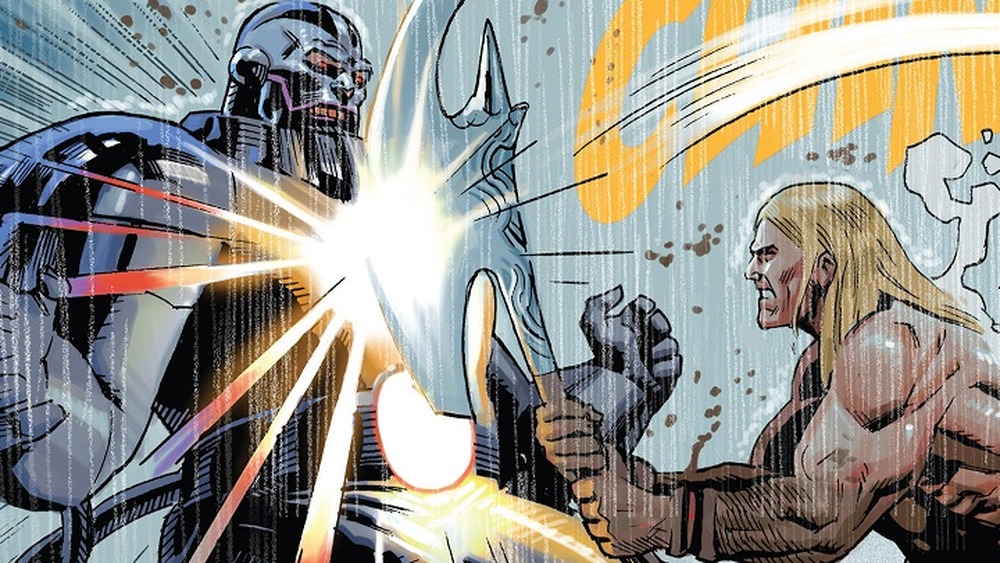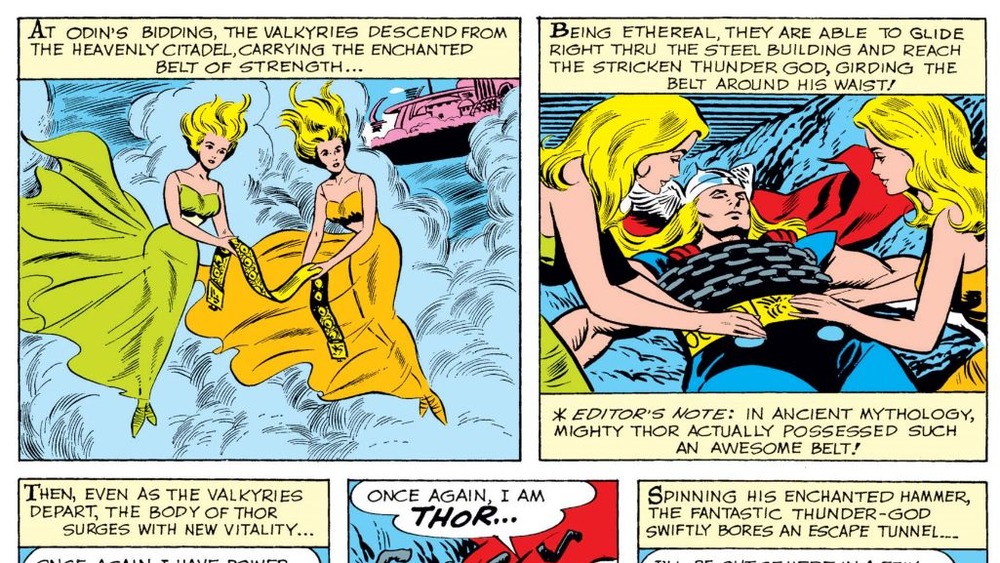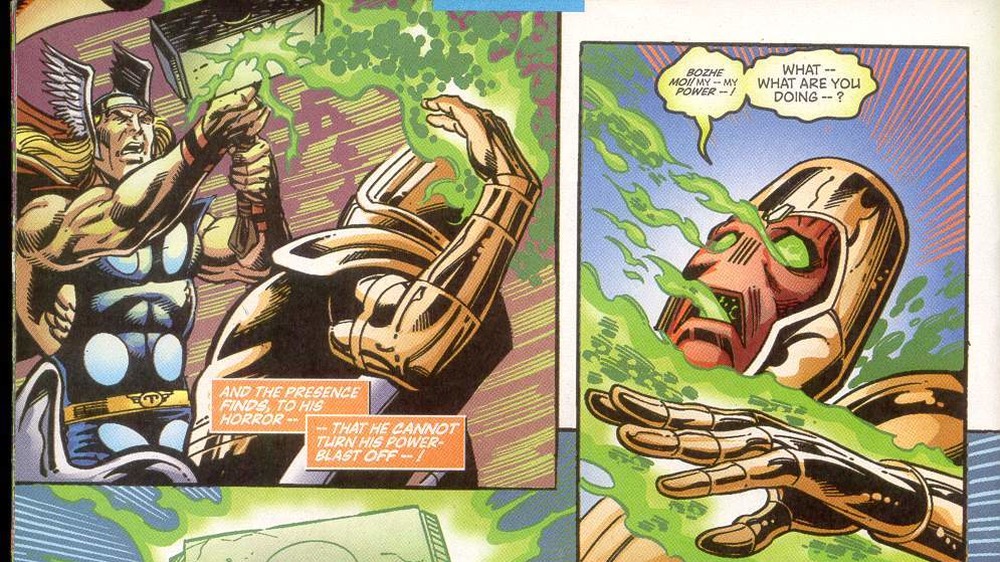Things About Thor That Didn't Make It Into The MCU
Marvel Studios had a tall order in bringing their superhero version of Thor to the big screen. Beyond the usual challenges you'll find in making just about any movie regardless of genre, while making 2011's Thor Marvel needed to adapt an entire world around the hero. Audiences had to learn not only about Thor and his mystical hammer Mjolnir but his family of gods, the golden realm of Asgard, the Bifrost, companion heroes like Sif and the Warriors Three, and a whole host of legendary realms with difficult to pronounce names. All things considered, they did a pretty good job.
But even after all the films Chris Hemsworth has appeared in as the God of Thunder — or how many more times he reprises the role — there will always be some stuff in the comics that just doesn't make it to the big screen. For example, there are innate abilities and other mythic resources Thor has at his command that we've never seen in the movies. Mjolnir is capable of much more than we've seen in live action. And the epic nature of his adventures have produced more versions of the character than we're likely to ever get a chance to see in any other single media.
Whatever the reasons we haven't seen these comics details and developments in a Marvel Studios adaptation yet, here's a look at things about Thor that haven't made it into the MCU.
Donald Blake
When Marvel's Thor first appeared in 1962's Journey Into Mystery #83, his creators figured out a way to give him a secret identity like other heroes. Mjolnir is found by the human Dr. Donald Blake and he is deemed worthy to wield it. Smacking the hammer on the ground causes Thor and Blake to switch places, and when it's Blake who's out and about, the hammer appears as a walking stick. Thor's secret identity comes with a weakness — if he should be separated physically from Mjolnir for too long, he will revert back to Blake's mortal form, which of course will be bad news if he's in the middle of fighting frost giants, trolls, or any other powerful bad guys.
Blake's had an interesting history in the comics. He's eventually revealed to be a mortal construct created by Odin to teach Thor humility. He disappears from Thor's story for a long time, but comes back with something of a villainous turn. After Thor asks Blake to once again act as his secret identity, he learns Blake has a plan to usurp him.
While Blake himself has never appeared in the films, the filmmakers paid tribute to Thor's old alter ego in his first solo film. Blake's name is on the tag stuck to a shirt Jane Foster (Natalie Portman) gives Thor. Later, it's Blake's name that Erik Selvig (Stellan Skarsgård) uses on the fake ID he makes for Thor to free him from S.H.I.E.L.D. custody.
The Warrior Madness
In the MCU, Thor sometimes resorts to solving problems with his fists too quickly. His incursion into Jotunheim in the beginning of Thor springs to mind, as does his throwdown with Iron Man (Robert Downey Jr.) in 2012's The Avengers, his brief assault on Tony in 2015's Avengers: Age of Ultron, and of course his abrupt beheading of Thanos (Josh Brolin) in the beginning of 2019's Avengers: Endgame. But even at his most enraged, we haven't seen anything like the infamous Warrior Madness take hold of Thor in the MCU.
The Warrior Madness is not so much a power Thor can access as it is an illness that may take ahold of him or other Asgardian warriors. When it the Warrior Madness is triggered, Thor's strength gets a significant boost, but it isn't something he uses as a tool — it makes Thor wild, attacking friend and foe alike. In one of the more recent examples, the Madness prompts Odinson to attack his longtime brother-in-arms Beta Ray Bill unprovoked in 2017's Unworthy Thor #3. He enters the Madness in one of his most vicious battles with the Hulk in 1996's Incredible Hulk #440. Perhaps his longest bout with the malady is in the 1993-'94 event "Blood & Thunder" when it causes Thor to lash out at friends and allies like Silver Surfer, Beta Ray Bill, and Adam Warlock.
Thor, the Herald of Thunder
Thor's adventures in the MCU have seen him pair up with interesting and unexpected allies. He's forced to work with his dishonest brother Loki (Tom Hiddleston) more times than he'd like, he helps free the gladiators of Sakaar in 2017's Thor: Ragnarok, and in 2018's Avengers: Infinity War he meets the Guardians of the Galaxy before any of the earthbound Avengers. But on the big screen, there's been nothing like his temporary alliance with one of Marvel's scariest villains — Galactus, the Devourer of Worlds.
In 2020's Thor #1, a weakened Galactus arrives on Asgard with cataclysmic news. Galactus comes from a universe that existed before the prime Marvel universe, and Silver Surfer tells Thor that the Black Winter, the same cosmic plague that destroyed Galactus' universe, has arrived to destroy the current one. Without asking, Galactus bestows his power upon Thor, increasing his already incredible might and making him the so-called Herald of Thunder. The plan is for Thor to help Galactus locate five specific worlds capable of giving the Devourer untold power with which he hopes to defeat the Black Winter. Not willing to be a servant like Galactus' former heralds, Thor refuses to let the him consume worlds before he has evacuated them of their people.
Without spoiling the story, as you might expect, things don't work out well between Galactus and his new herald — largely because the Devourer eventually reveals an ulterior motive.
The Thor Corp
While it's usually Thor handling either Mjolnir or Stormbreaker in the MCU, we've seen others use the hammers. Hela (Cate Blanchett) is shown wielding Mjolnir in previously hidden palace murals in Ragnarok, Captain America (Chris Evans) famously wields both hammers in Endgame, and Vision (Paul Bettany) is able to wield Mjolnir in Age of Ultron. But we have yet to see anything like so many hammer-wielders in the MCU that they can form their own team, while this has happened a number of times in the comics.
By 1993, there were enough Thor-themed heroes to launch the miniseries Thor Corps. The comic unites Thor Odinson, the alien Beta Ray Bill, the human hero Thunderstrike, and Dargo — a young man from the 26th century worthy of wielding Mjolnir — all in one team. The four embark on an adventure through time and space to save reality and battle villains and heroes from all over the multiverse.
The team didn't catch on enough to earn its own regular title, but years later the name Thor Corps was used again in the 2015 Secret Wars event. In this event, Doctor Doom — in the aftermath of the universe's destruction — recreates it in the form of the patchwork planet Battleworld and names himself the world's one and only God. Doom's police force is the Thor Corps — hundreds of different versions of Thor from all across the universe.
The Clone Thor
Both Thor and Hulk (Mark Ruffalo) are absent from Earth during the events of 2016's Captain America: Civil War. There's a good chance either Iron Man or Cap would've loved to have had the God of Thunder on their side in the conflict, though neither of them go as far as the pro-registration heroes go in the comics to make that happen.
One of the darkest moments of the comic book event that inspired the movie – the 2006 event Civil War – comes with what appears to be the return of Thor. Thor is missing and presumed dead when someone appearing to be the Thunder God shows up on the last page of Civil War #3. In the following issue, he unleashes on the fugitive anti-registration heroes, killing Bill Foster, a.k.a. Goliath. We soon learn this is, in fact, a clone of Thor, courtesy of Reed Richards and Tony Stark. In the final battle between the warring heroes in Civil War #7, the Greek hero Hercules crushes the clone's head with his own hammer.
While he was nicknamed "Clor" by most fans, the clone gives himself a new name – Ragnarök — after reviving in 2009's Avengers: The Initiative #21. He's since worked as a villain in Norman Osborn's team of Dark Avengers, as well as joining both the Thunderbolts and the second, Osborn-free version of the Dark Avengers.
Thors of the future and past
It took until 2019's Avengers: Endgame for us to see Marvel's heroes using time travel as a tool. Thor is one of those time travelers, going back to the events of 2013's Thor: The Dark World to retrieve the Aether from Jane Foster's body — though Rocket (Bradley Cooper, Sean Gunn) really does all the work while Thor gets Mjolnir and has a heart-to-heart with his mom. Meanwhile in the comics, the wonders of time travel have given the God of Thunder the opportunity to meet and team up with two very different versions of himself — a younger Thor, and the older King Thor.
The younger Thor is — if you can believe it — less humble than the present day version. Not yet worthy to wield Mjolnir — and cursing every time he tries — the younger Thor is instead often found with the powerful axe Jarnbjorn. From the other end of time is the one-eyed and one-armed King Thor. Often appearing more like Odin than Thor, King Thor has little patience for his younger counterparts.
Starting at the beginning of writer Jason Aaron's long run on Thor's various titles — 2012-'15's Thor: God of Thunder — both old and young versions of Thor feature prominently in flashbacks and flash forwards. Both also come to the present Thor's aid against Gorr the God Butcher, and later in the 2019 event War of the Realms.
Toothgnasher and Toothgrinder
In the movies we've seen not only how mystic hammers like Mjolnir and Stormbreaker can lift Thor into the air, but how Stormbreaker can actually bridge the distance between worlds. What we have not seen, however, are Thor's other famous forms of transportation — his goats Toothgnasher and Toothgrinder.
Based on the mystical goats Tanngrisnir and Tanngnjóstr of the same Norse myth from which Thor is pulled, Toothgnasher and Toothgrinder make their first comic book appearance in 1976's Thor Annual #5. Along with being able to fly through the cosmos and being a lot stronger than your average goat, the pair — if killed — come back to life the next day. In Norse myth, Thor would actually eat the goats every night only to have them back and ready to serve him the following day.
The goats haven't been around as much as other characters in Thor's mythos, though during the period when the Odinson is deemed unworthy of Mjolnir, they come in handy since he no longer has the hammer to transport him. With the 2019 event War of the Realms, the goats actually got to branch out a little bit — at least one of them did, anyway. In the 2019-'20 miniseries Punisher: Kill Krew, Toothgnasher joins the ragtag team of Punisher, Black Knight, Juggernaut, and Foggy Nelson to scour the Ten Realms for criminals guilty of murdering innocent humans.
Mjolnir has a mind of its own
In the MCU, Mjolnir has been depicted as little more than a tool. A mystical and incredibly powerful tool, but ultimately just a weapon. However, in the comics — particularly during Jane Foster's time as the thunder goddess Thor — there is an intelligence at work in the relic.
Early in Foster's time as Thor, she suspects the weapon harbors an intelligence. During battles the hammer sometimes acts unpredictably, like ping-ponging around the battlefield as if it were ricocheting. In 2016's Mighty Thor #11, Thor has something of a face-to-face conversation with that intelligence. Without her command, the hammer creates a duplicate of Foster to appear beside Thor in order to fool S.H.I.E.L.D. agents who believe they've discovered her secret identity. At the end of the issue, as it changes from the false Jane Foster form back into the hammer, the being inside Mjolnir tells the real Jane Foster that it chose her to be its wielder.
Moments later, after Jane simply mentions she'd like to know if the hammer is alive, Mjolnir transports her without warning to the library of Omnipotence City, the Nexus of all the gods. There, Thor learns that Odin battled the God Tempest — a living storm — and trapped it within a piece of Uru metal. The storm is what the power of Mjolnir comes from, and the intelligence within the hammer is that of the God Tempest.
His adventures from before the 20th century
In Avengers: Infinity War, Thor tells Rocket he's 1500 years old. So that means the Thunder God has been around for some of history's landmark events. However, beyond the brief flashback to his childhood in the beginning of 2011's Thor, we don't see much of his past in the MCU.
In the comics, the writers have managed to take a bit more advantage of Thor's long life. For example, in 2013's Uncanny Avengers #6, we learn that Thor battles the evil mutant Apocalypse and his Horsemen in the early 11th century, long before the X-Men would clash with the villain. Earlier, in 1976's Thor Annual #5, Thor answers a call for aid from Vikings battling Greek warriors, who in turn have the aid of the mighty Hercules. The two heroes' clash triggers a war between Asgard and Olympia. There's a bit more of an emotional flashback in 2001's Captain Marvel #17, when the story opens with Thor lamenting the comparatively short lives of mortals with talk of Vikings whose names he can't remember.
It's kind of surprising, come to think of it, that Marvel Studios hasn't taken the opportunity to show Thor in other times. Two of the Thor films open with flashbacks to distant history, but neither of them feature the Thunder God. It's almost like Thor is trying his best to not remind Captain America he isn't the oldest senior citizen in the Avengers.
The belt of strength
Thor isn't the strongest Avenger, at least not according to the Quinjet that he finds on Sakaar in Ragnarok. Still, he's pretty strong. If you can go toe-to-toe with the likes of the Hulk and Iron Man, you're not hurting for muscle. Even so, sometimes he needs a little help — and sometimes that help comes in the form of Megingjord, Thor's mystic belt of strength. When he wears it, his already immense strength is doubled. We know the belt exists in the MCU, but we've never actually seen it. In 2017's Spider-Man: Homecoming, Happy (Jon Favreau) mentions it as one of the items being loaded onto the transport for the Avengers' new headquarters.
Why doesn't he just wear something like that all the time? Well, using Megingjord takes a lot out of the Thunder God, so it's usually held in reserve for when there's no other choice. The belt makes its first comic book appearance in 1963's Journey Into Mystery #91 when Odin sends valkyries with the belt to his son, who needs it to escape when he is trapped by the magician Sandu. In other instances he uses it only when battling particularly difficult enemies, like the already powerful Kurse boosted by the powers of the Beyonder in 1986's Thor #363, or one of the Celestials in 1988's Thor #388.
Considering Megingjord was on the transport destroyed in Homecoming, it could very well be that no one knows where it is.
Mjolnir can do a lot more than what you've seen in the MCU
The MCU portrays Mjolnir as an extremely powerful weapon. Not only do you not want to be hit by that thing, it has abilities beyond just knocking people around. It can summon and direct Thor's lightning, it allows him to fly, and it always returns to him — even racing through space, as we see in The Dark World, to get back to its wielder. But compared to what we see in the comics, the Mjolnir of the MCU barely scratches the surface.
Mjolnir is surprisingly versatile. With it, Thor can teleport himself and others to other locations, to other dimensions, and in some cases even through time. He can use Mjolnir to phase through solid objects like the Vision, and conversely he can use Mjolnir to disrupt others' phasing powers — he does this in 1991's Thor #428 when Kitty Pryde phases him halfway through concrete. One of its darker abilities is to drain someone's life force. He uses this on the villain the Presence in 2001's Avengers #44, when he believes the villain has murdered his teammates.
One of its most destructive abilities is its God Blast. With the God Blast, Mjolnir can gather the very life force from within Thor and project it at an enemy. He uses it only against Marvel's most powerful or nigh-indestructible foes. He's used it successfully against Ego the Living Planet, the Celestial Exitar, and even Galactus, the Devourer of Worlds.
